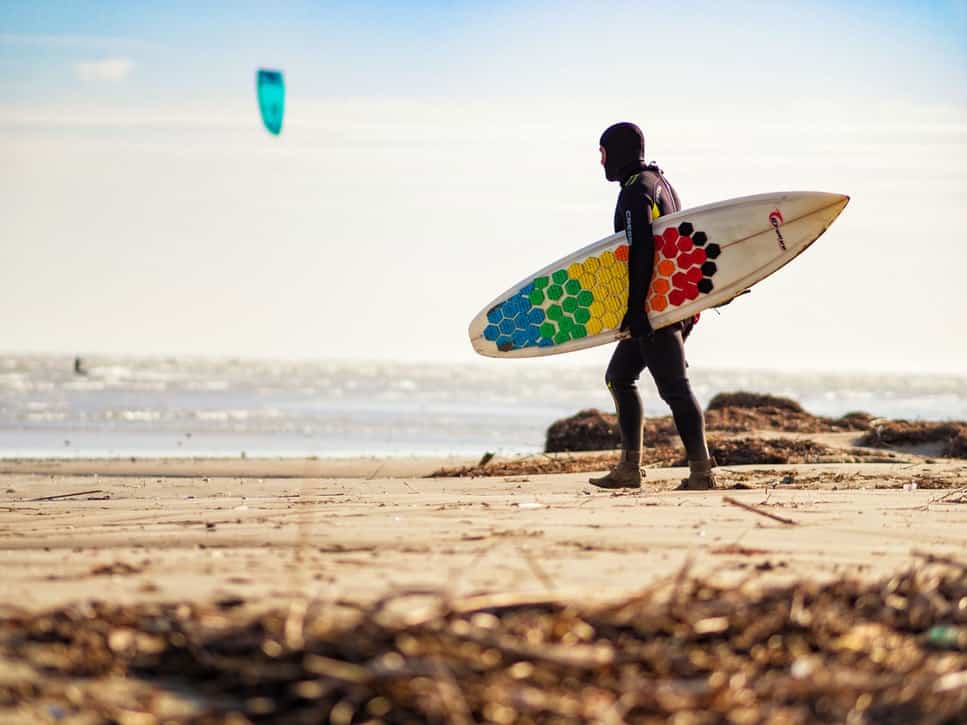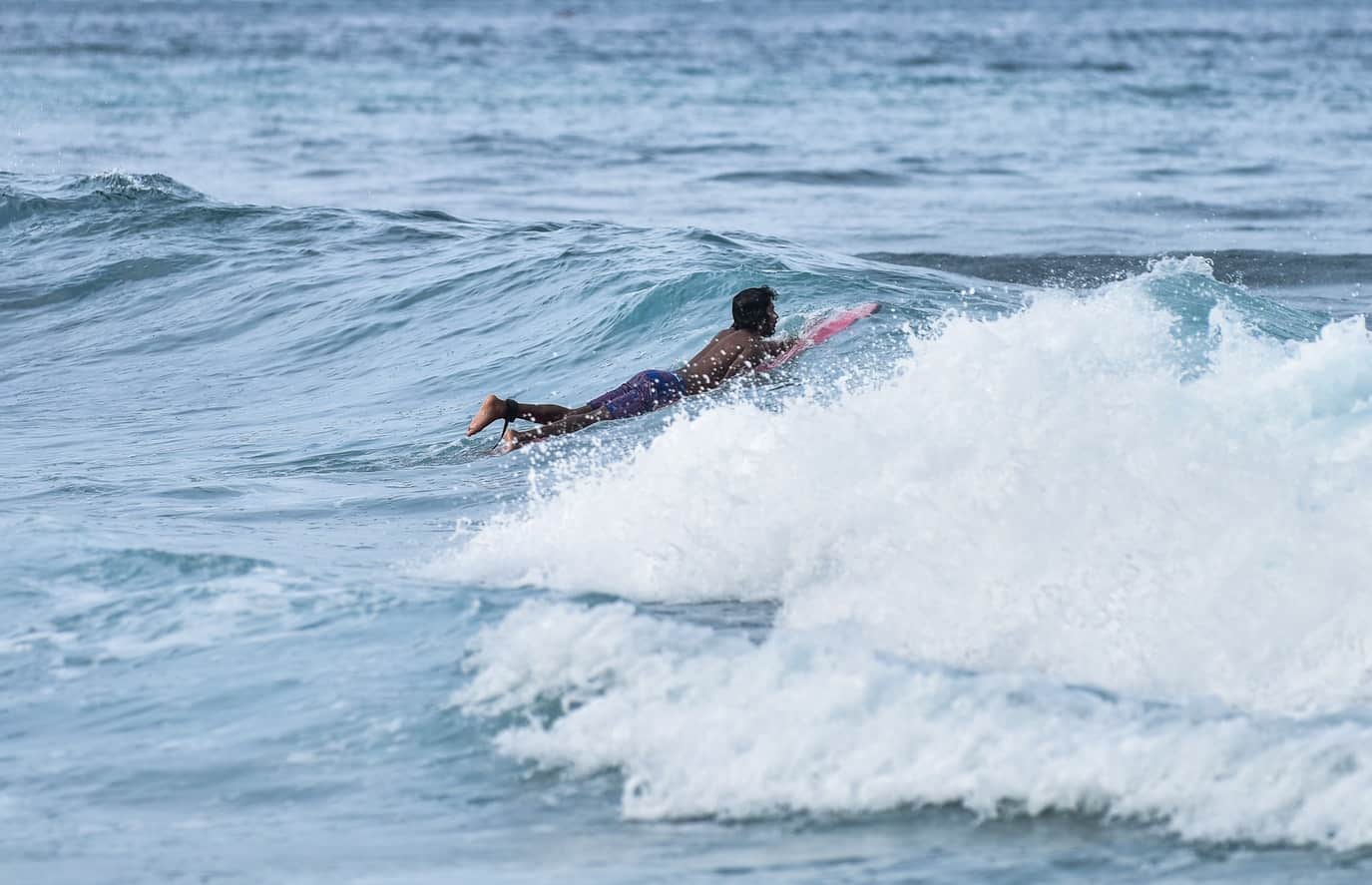Surfing is arguably one of the greatest overall activities. Being out in the water, the feeling of catching a wave.
But have you ever experienced that ache in your back after a great session? Or even worse, continuing pain even days after?
So, is surfing bad for your back? Lower back pain is a fairly common issue amongst surfers, characterized by tight or spasming muscles combined with a constant dull ache. This pain is often due to over arching and weak support muscles. Which begs the question, is surfing bad for your back?
It turns out that the truth is a little more than a simple yes or no. While surfing is actually a great form of exercise, poor form and technique can result in injury, including back pain.
Surfing requires strong use of many muscle groups, like the stabilizing muscles. Most notably the core, hips and thighs. If these muscles aren’t properly engaged, or aren’t properly strengthened, injury can occur. Specifically in the case of surfing, if the core and hips aren’t properly engaged, the back will have to overcompensate
This overcompensation can lead to muscle spasms or even herniated disks, but training these stabilizer muscles will go a long way to preventing injury. In addition to maintaining proper posture and form, proper technique is essential to maintaining a healthy back while surfing.
From paddling out, popping up and dropping in, there’s plenty of room to over arch or tweak the back resulting in pain from surfing.
Causes of Surfing Back Pain
From paddling out to riding a wave to shore, many positions in surfing lend themselves to the possibility and cause of back pain.
Both newbies and experienced surfers alike tend to be at the highest risk for back injury. For new surfers, this is due to a lack of knowledge and experience. When it comes to experienced surfers who have been enjoying the waves for twenty years or more, it’s generally from overuse and repetitive motion.
Overarching
Overarching is often the main culprit of this kind of pain in surfers. This overarching is called hyperlordosis. Lordosis refers to the natural inward curve of the spine, while hyperlordosis is when this inward curve becomes exaggerated.
Paddling out requires laying in a prone position (belly down). This in itself causes a dip in the low back. Then, raising the head and shoulders to paddle and navigate intensifies this curve. The combo places all the pressure right into the back that can lead to surfing back pain.
Lack of Core Strength
When popping up, you typically jump from lying belly down, either straight into a standing or crouched position. This motion requires great core strength to keep the body from arching even further, thus a source of more back pain from surfing. Even dropping in and riding the wave can cause strain if you’re not paying attention.
Poor Balance
Poor balance and standing posture combined with loose ab muscles causes tweaks and kinks when twisting and moving on your board.

How To Improve Surfing Form and Technique
Luckily, surfing injuries are easy to avoid. There are so many ways to improve the necessary muscle strength, as well as form needed to prevent surfing back pain. Even if you’ve never experienced an injury, it’s better to take a proactive approach instead of treating injuries when it’s too late.
Hire a Coach
The first and simplest way to improve your form is to hire a coach. An experienced surfing coach can work one on one with you, showing you best practice and critiquing your current form that may be contributing to back pain.
YouTube
If hiring a coach isn’t an option, try watching Youtube videos relating to surfing back pain and implement their knowledge. YouTube can be a great source of information from experts, and you don’t even have to leave the house!
Pop Up Method
There is also an alternative pop up method, called the “knee pop-up” that takes lower back strain out of the equation entirely. This technique involves kneeling or crouching during paddling and using this position to jump into standing.
Practice
No matter which way you choose to improve your form, by far the most effective way to improve back pain is practice and strength training. Practice using proper form out of the water, as a warm up or on its own, to get used to how you should feel in the water. When not surfing, try exercises to strengthen your stabilizer muscles (the trunk, hips, and upper legs). With these two in conjunction, your ability to surf without pain is greatly improved.
Specific Exercises To Do After Surfing to Lessen Back Pain
Strength is key for protecting the back, which is why these simple power-building exercises can help:
- Pelvic Tilt
While laying on your back, bend knees and place feet in line with hips. Slowly roll the lower back down until it touches the ground. At this point, the abdominal muscles should feel engaged. Slowly roll between flat and resting position to equal one rep. This exercise helps to relieve pain and strengthen abs
- Partial Crunches
Starting in Pelvic Tilt form, place fingertips behind the ears with elbows pointed out and shoulders down. Slowly raise head and shoulders off the ground while keeping low back pressed to the floor. Maintaining this positioning, slowly lower back down to equal one rep.
- Bicycles
Lie down with your back pressed to the floor, legs directly above hips, knees bent at 90 degree angle. Place fingertips behind the ears, elbows pointed out. Extend left leg out while raising left shoulder towards opposite knee. All while keeping low back firmly on the ground. Slowly return to starting position and repeat other side
- Plank
Move into a push up position. Straight legs, toes together, hands directly below shoulders, neck and spine in straight line, eyes looking down. Pull abdominals towards the back, keeping the body in a straight line. Hold position as long as you can keep proper form.
- Wall Sits
With your back against the wall, slowly lower into squat position. Bend knees into a 90 degree angle, feet and ankles directly below the knee. Press low back into the wall and engage core. Hold position as long as you can keep proper form.
- Child’s Pose
Sitting on your knees, spread the knees slightly wider than your hips. Slowly lower your upper body down until your forehead rests gently on the floor in front of you. Place both arms straight out in front of you or at your sides with your fingers pointing towards the back of the room. Breathe deeply and hold the position for as long as you are comfortable. - Knees to Chest
Lay flat on your back on the floor. Slowly, bring one leg into your chest, bent at the knee. Repeat on the other side. Hug both knees in as close as you can comfortably hold the position and breathe.
Experts also recommend a regular yoga or pilates practice to keep the body strong and flexible. When implemented as part of your surfing routine, you can greatly diminish lower back pain.
Related Questions
Is Surfing Everyday Good For You?
Although it may seem like surfing comes with a high risk of injury, it’s actually one of the most enjoyable forms of exercise. Nothing beats the peace and joy of being out in the water! It simply requires knowledge and skill to refrain from injury, and we all know the best way to gain that knowledge and skill is through practice. That means that surfing regularly is the only way to truly implement your new training and techniques.
Is Surfing Good Exercise?
Surfing is fantastic exercise!. Not only will a regular surf pratice lead to better overall health and muscle tone, it’s a lot more fun than going to a gym. Again, surfing requires a lot of physical power and endurance. Paddling through the waves, popping up, balancing while riding a wave, is a full body workout all on its own.
The bottom line is that surfing as a lifestyle is a huge benefit to overall health.
In general, surfing itself is not bad for your back, but surfing with poor form and compromised strength can lead to injuries and discomfort.
Whether you choose to work with a coach or learn on your own, it’s important to prioritize strength and form with regular exercise and proper instruction. Not only will you feel the difference and enjoy significant relief, you’ll also get to enjoy the benefits of surfing for life.

